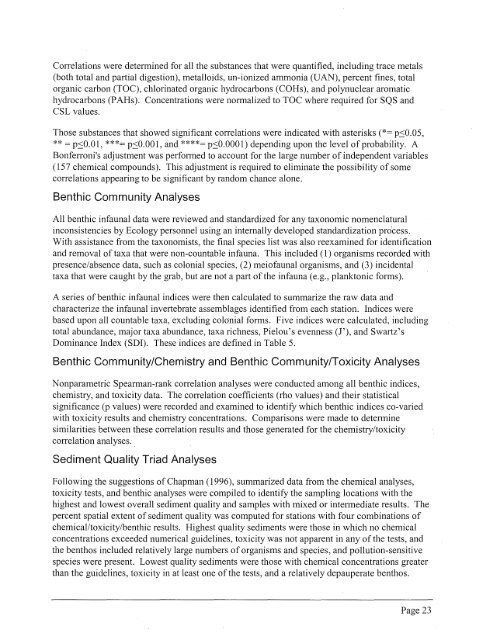Sediment Quality in Puget Sound Year 2 - Center for Coastal ...
Sediment Quality in Puget Sound Year 2 - Center for Coastal ...
Sediment Quality in Puget Sound Year 2 - Center for Coastal ...
Create successful ePaper yourself
Turn your PDF publications into a flip-book with our unique Google optimized e-Paper software.
Correlations were determ<strong>in</strong>ed <strong>for</strong> all the substances that were quantified, <strong>in</strong>clud<strong>in</strong>g trace metals<br />
(both total and partial digestion), metalloids, un-ionized ammonia (UAN), percent f<strong>in</strong>es, total<br />
organic carbon (TOC), chlor<strong>in</strong>ated organic hydrocarbons (COHs), and polynuclear aromatic<br />
hydrocarbons (PAHs). Concentrations were normalized to TOC where required <strong>for</strong> SQS and<br />
CSL values.<br />
Those substances that showed significant correlations were <strong>in</strong>dicated with asterisks (*= p0.05,<br />
** = po.~l, ***= pO.001, and ****= pg.0001) depend<strong>in</strong>g upon the level of probability. A<br />
Bonferroni's adjustment was per<strong>for</strong>med to account <strong>for</strong> the large number of <strong>in</strong>dependent variables<br />
(157 chemical compounds). This adjustment is required to elim<strong>in</strong>ate the possibility of some<br />
correlations appear<strong>in</strong>g to be significant by random chance alone.<br />
Benthic Community Analyses<br />
All benthic <strong>in</strong>faunal data were reviewed and standardized <strong>for</strong> any taxonomic nomenclatural<br />
<strong>in</strong>consistencies by Ecology personnel us<strong>in</strong>g an <strong>in</strong>ternally developed standardization pro'cess.<br />
With assistance from the taxonomists, the f<strong>in</strong>al species list was also reexam<strong>in</strong>ed <strong>for</strong> identification<br />
and removal of taxa that were non-countable <strong>in</strong>fauna. This <strong>in</strong>cluded (1) organisms recorded with<br />
presencelabsence data, such as colonial species, (2) meiofaunal organisms, and (3) <strong>in</strong>cidental<br />
taxa that were caught by the grab, but are not a part of the <strong>in</strong>fauna (e.g., planktonic <strong>for</strong>ms).<br />
A series of benthic <strong>in</strong>faunal <strong>in</strong>dices were then calculated to summarize the raw data and<br />
characterize the <strong>in</strong>faunal <strong>in</strong>vertebrate assemblages identified from each station. Indices were<br />
based upon all countable taxa, exclud<strong>in</strong>g colonial <strong>for</strong>ms. Five <strong>in</strong>dices were calculated, <strong>in</strong>clud<strong>in</strong>g<br />
total abundance, major taxa abundance, taxa richness, Pielou's evenness (J'), and Swartz's<br />
Dom<strong>in</strong>ance Index (SDI). These <strong>in</strong>dices are def<strong>in</strong>ed <strong>in</strong> Table 5.<br />
Benthic Community/Chemistry and Benthic Community/Toxicity Analyses<br />
Nonparametric Spearman-rank correlation analyses were conducted among all benthic <strong>in</strong>dices,<br />
chemistry, and toxicity data. The correlation coefficients (rho values) and their statistical<br />
significance (p values) were recorded and exam<strong>in</strong>ed to identify which benthic <strong>in</strong>dices co-varied<br />
with toxicity results and chemistry concentrations. Comparisons were made to determ<strong>in</strong>e<br />
similarities between these correlation results and those generated <strong>for</strong> the chemistry/toxicity<br />
correlation analyses.<br />
<strong>Sediment</strong> <strong>Quality</strong> Triad Analyses<br />
Follow<strong>in</strong>g the suggestions of Chapman (1 996), summarized data from the chemical analyses,<br />
toxicity tests, and benthic analyses were compiled to identify the sampl<strong>in</strong>g locations with the<br />
highest and lowest overall sediment quality and samples with mixed or <strong>in</strong>termediate results. The<br />
percent spatial extent of sediment quality was computed <strong>for</strong> stations with four comb<strong>in</strong>ations of<br />
chemicalltoxicitylbenthic results. Highest quality sediments were those <strong>in</strong> which no chemical<br />
concentrations exceeded numerical guidel<strong>in</strong>es, toxicity was not apparent <strong>in</strong> any of the tests, and<br />
the benthos <strong>in</strong>cluded relatively large numbers of organisms and species, and pollution-sensitive<br />
species were present. Lowest quality sediments were those with chemical concentrations greater<br />
than the guidel<strong>in</strong>es, toxicity <strong>in</strong> at least one of the tests, and a relatively depauperate benthos.<br />
Page 23







